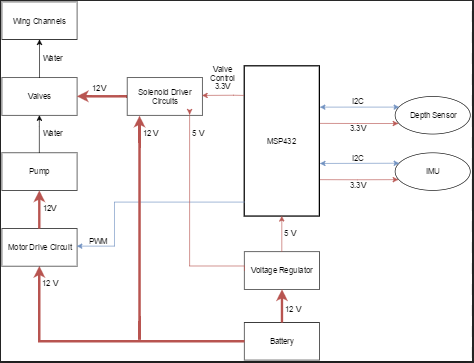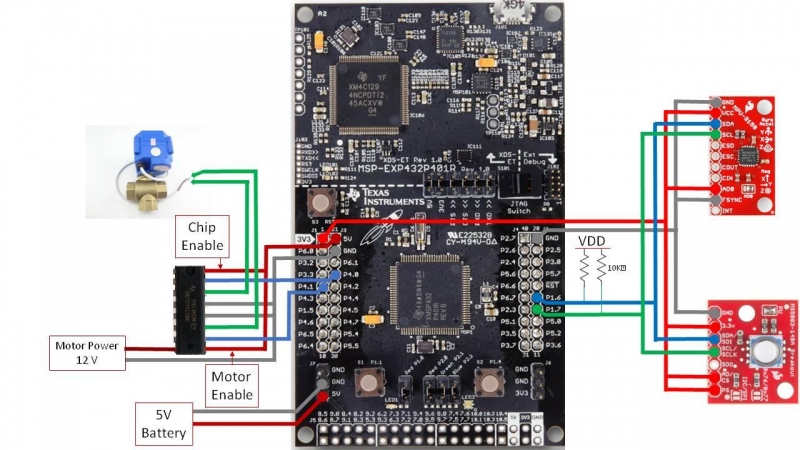
System Block Diagram
Hull Design & Waterproofing
Ensuring the electrical and mechanical systems are protected from the water is vital for the survival of the prototype in an aquatic environment. As such, much consideration was put into the the robot’s hull and waterproofing. All electronic components are housed within a smaller enclosure that is water resistant independent of the primary hull. The internal enclosure acts as a second defense should the primary hull leak. The plan was to buy a commercially available pressure vessel to ensure its success. This hull was planned to be rounded into a hydrodynamic shape by use of silicone. The primary hull had an access panel to allow for modifications and repairs to the internal components.
System Controls
Motion through the water is theoretically achieved by actuating each of the fin segments in sequence in order, creating sinusoidal motion. Each section is raised by both pressurizing the low channel set and draining the high channel set. Conversely, a section is lowered by pressurizing the high channel set, and draining the low channel set. The valves connect each partition to either high pressure when unpowered, or low pressure when the valve is powered, thereby filling, or draining its channel set. By powering either the top or the bottom exclusively, and sequencing these top/bottom pairs from front to back, the fin may achieve sinusoidal motion.
In order to help achieve desirable movement, the robot’s two sensors provide feedback about its pose in the water. The information from the IMU and pressure sensor is fed into the robot’s microcontroller, the MSP432. A PID control prototype was developed to regulate the frequency of oscillation to move the robot around a horizontal plane.

Pinout Diagram
Shown above is a pinout diagram of the MSP432 and peripheral electrical systems. The sensors on the right from top to bottom are the IMU and the pressure sensor. The SDA pins on both sensors are connected together and to the pin P1.6 on the MSP432. Likewise, the SCL pins are connected together and to P1.7. These form the I2C bus. SDA is the data line (blue), where information can be sent in either direction. For the purpose of this project, the MSP432 is the master, sending requests for information to the sensors. The sensors are the slaves, sending gathered data back to the MSP432 for processing. The SCL line (green) is for the clock. It is important that these are connected together and synchronized because bits are sent on clock cycles.
In order to control which sensor the MSP432 is communicating with, it needs to send the address of the slave with the start condition. Each sensor has an address as described in its datasheet. For instance, the pressure sensor has the address 0b0111011n, where n is replaced with a 1 if the CSB pin is pulled high and 0 if the CSB pin is pulled low. This theoretically allows two of the same sensors to be placed on one bus. In this configuration, the pin is pulled high, so the address is 0b01110111. The IMU has a similar situation by pulling AD0 high, setting the LSB of the address to 1.
The PS pin on the pressure sensor is pulled high to select I2C mode, because it is also capable of communicating with SPI. The decision to communicate with this sensor using I2C was made to keep the communication protocol consistent with the IMU, which is only capable of I2C.
To the left of the MSP is the H-bridge motor driver circuit. Motor power (dark red) is provided by a 12V battery, and chip power (chip enable) is provided by the MSP (light red). Ground for the circuit (grey) is connected to both the MSP ground and ground of the battery. By providing a PWM signal from P4.0 and P4.1 (blue), the voltage level at the adjacent output pins (green) can be controlled. With no input signal, the corresponding output pin will be grounded, and with a 100% duty cycle (a high pin) input, the output will be motor power (12 V). By driving one input pin low and the other high, a voltage difference of 12 V in one direction is created across the valve’s power cables. The direction can be switched by swapping which input pin is high and which is low. By this method, the valve can be driven in either direction at the command of the microcontroller. By mirroring the input, output, and ground pins across the H-bridge, and connecting them to different input pins, another valve, and the same ground rail (grey) respectively, a second valve can be driven through the same motor driver chip. In order for this to work, the top-left pin, which serves as the second half’s motor enable, must be connected to the 5 V (light red) rail.
Design Limitations
Common silicone exists that can withstand up to 1200 psi (80 atm) allowing a depth of almost a half mile (800 meters), proving the feasibility of a deeper diving model. It is worth noting this design is not feasible for extreme depth, as the average ocean depth is 2.3 miles (3700 meters) and would require over 370 atm of pressure to reach. The limitations on flexible enough materials make this a current impossibility.
Projected Budget
In order to better organize the project, an estimated budget was established. The following figures are rounded up and account for shipping, taxes, and has anticipated extra required parts. Most of the needed tools and equipment were provided by WPI or team members’ personal supplies. For this reason, tool costs were not included in the budget.
Material | Description | Units Used | Cost per Unit | Total Cost |
Silicon for Molding | material for molding fins | 1 | $200.00 | $200.00 |
Hull Casing | pressure housing for components | 1 | $500.00 | $500.00 |
Pump | pressurization of fluid for actuation | 1 | $120.00 | $120.00 |
Valves | automated valves to control actuation | 12 | $25.00 | $300.00 |
Reservoir Tank | tank to hold excess hydraulic fluid | 1 | $10.00 | $10.00 |
PVC Piping | piping & fittings used for pressure system (ft) | 20 | $2.50 | $50.00 |
Hydraulic Fluid | working fluid in our system | 1 | $20.00 | $20.00 |
Large Battery | power for the pump and valves | 1 | $60.00 | $60.00 |
Small Battery | power for the micro-controller | 1 | $20.00 | $20.00 |
Large Motor Driver Circuit | system to power pump | 1 | $30.00 | $30.00 |
Small Motor Driver Circuit | system to power 2 valves | 6 | $5.00 | $30.00 |
Microcontroller | "the brain" of the robot | 1 | $25.00 | $25.00 |
IMU | sensor for navigation in water | 1 | $30.00 | $30.00 |
Pressure Sensor | sensor for safe depth detection | 1 | $65.00 | $65.00 |
Other ECE Components | misc parts needed for interfacing | 1 | $40.00 | $40.00 |
Project Total: $1,500.00
